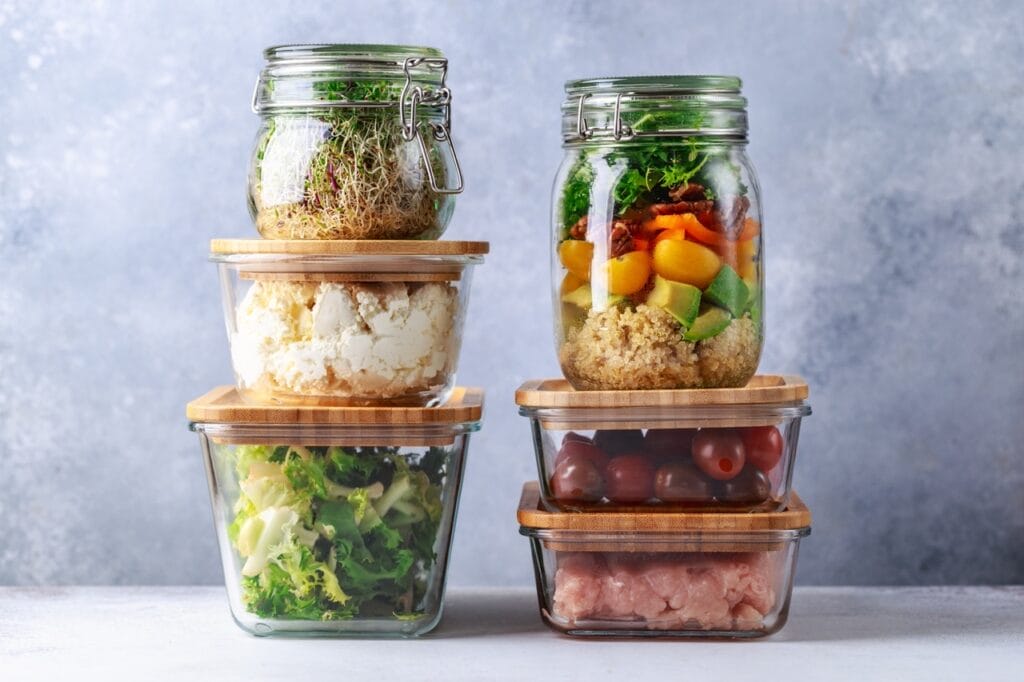Creating a lasting home environment for healthy eating is more than just picking the right foods at the grocery store. This journey includes careful planning, thorough organization, and a strong commitment to making healthier choices easy and attractive for every family member. The heart of building a health-focused household is not just in choosing nutritious foods but also in creating a space that naturally supports these choices.
Starting on this path brings many benefits, including a big positive effect on overall health and the development of lifelong healthy eating habits as well as impact weight. A good plan for meal prep, along with smart grocery shopping and organizing your kitchen, lays the foundation for a lifestyle that values nutrition and balance.
Planning for Success
Starting a foundation for healthy eating begins with smart planning. This method makes sure that every meal and snack adds positively to your family’s nutritional needs, promoting a lifestyle that supports health and energy. Here’s how you can plan for success:
Understanding Nutritional Needs
Importance of a Balanced Diet: A balanced diet is vital for giving the body the essential nutrients it needs to work well. It includes a variety of foods from all food groups: fruits, vegetables, grains, protein sources, and dairy or alternatives. The aim is to give the body vitamins, minerals, fiber, protein, and healthy fats to support overall health.
Tailoring to Dietary Requirements of Family Members: Every family member might have different nutritional needs based on age, gender, activity level, and health conditions. It’s important to consider these differences when planning meals. For example, growing kids may need more calcium and protein for strong bones and muscles, while adults might focus on heart-healthy fats and fiber. Taking care of dietary restrictions or allergies is also critical to ensure everyone’s health and safety.
Setting Realistic Goals
Establishing Achievable Dietary Goals for the Family: Set realistic and clear goals that encourage small changes towards healthier eating habits. For instance, adding one new vegetable or fruit each week, or planning for meatless meals twice a week, can be small steps toward diversifying your diet and eating more vegetables.

Incorporating Variety and Balance: Aim for a colorful plate at each meal to ensure you eat a mix of nutrients. Try new foods regularly to expand your family’s taste and nutritional intake. Balancing carbohydrates, proteins, and fats and including plenty of fiber-rich foods can help keep energy levels steady and support digestive health.
Meal Planning
Weekly Meal Planning Strategies: Set aside time each week to plan meals and snacks. This can help reduce stress and avoid unhealthy eating choices. Planning also makes grocery shopping more efficient and cost-effective, as you’ll buy only what you need.
Importance of Including All Meal Types and Snacks: Make sure your meal plan includes breakfast, lunch, dinner, and snacks. A full plan helps keep energy levels steady throughout the day and prevents overeating or choosing less nutritious snack options.
Tools and Apps to Aid Meal Planning: Use technology to make meal planning easier. Many apps and online tools offer features like recipe ideas, nutritional information, and shopping lists based on your meal plan. Some popular options include Mealime, Paprika, and Yummly. These tools can save time, reduce food waste, and support your healthy eating goals by keeping you organized and inspired with new meal ideas.

By adopting these strategies, you’re on your way to creating a sustainable, healthy eating environment at home. Planning for success is the first step toward reaching your family’s health and wellness goals, creating a strong foundation for nutritious eating habits that last a lifetime.
Smart Grocery Shopping
Choosing smart grocery shopping methods is key to keeping a lasting home environment for healthy eating. It makes sure your pantry and fridge are filled with nutritious ingredients that match your meal plans. Here’s how to shop smartly with health and efficiency in mind:
Creating a Master Shopping List
Based on Weekly Meal Plans: Before you go to the grocery store, make a detailed shopping list from your weekly meal plans. This list guides you to buy only what you need for the week’s meals and snacks, reducing waste and unnecessary spending.
Prioritizing Whole Foods and Minimally Processed Options: Make your list focus on whole foods, such as fruits, vegetables, and lean meats and proteins, whole grains, and healthy fats. These foods should be the main part of your grocery shopping. Minimally processed foods, like canned beans or frozen vegetables without added sauces or sugars, are also good and convenient choices. Choosing these items means your meals are based on nutrient-rich ingredients.
Understanding Food Labels
What to Look for and What to Avoid: Knowing how to read and understand food labels is important for making smart choices. Look for items with short ingredient lists, showing minimal processing. Pay attention to serving sizes, and the amounts of added sugars, sodium, and saturated fats, which should be limited. On the other hand, look for foods high in dietary fiber, vitamins, and minerals. Understanding these labels helps you choose the healthiest options and avoid foods that might not be good for your healthy eating goals.

Shopping Tips
Shopping on a Full Stomach to Avoid Impulse Buys: Don’t go grocery shopping when you’re hungry. Hunger can make it hard to think clearly, leading to quick decisions that favor sugary, fatty, or salty snacks over healthy options. Eating before you shop ensures you stick to your shopping list and make choices that fit your health goals.
Buying in Bulk for Non-Perishable Items: Save money by buying non-perishable items in bulk. Whole grains, dried beans and lentils, nuts, seeds, and frozen goods are great for bulk buying. This not only saves money but also makes sure you always have healthy staples available.
Seasonal Shopping for Fruits and Vegetables: Choose to shop for fruits and vegetables that are in season. Seasonal fruit and produce are usually fresher, tastier, and cheaper. It also adds variety to your diet as you try different fruits and vegetables throughout the year.
By using these smart grocery shopping tips, you can greatly improve your diet while managing your food budget better. This approach makes sure your home is always filled with the ingredients you need to support your family’s health and wellness through nutritious, tasty meals.
Organizing the Home Environment
Creating a home environment that supports healthy eating starts with how you organize your kitchen, pantry, refrigerator, freezer, and dining area. These areas can greatly influence your eating habits and choices. Here’s how to organize them for success:
Kitchen Setup
Organizing the Kitchen and Pantry for Healthier Choices: Start by cleaning out your kitchen and pantry. Get rid of items that don’t fit with your healthy eating goals and give away what you won’t use. Arrange your space so that whole foods and minimally processed options are the easiest to see and reach. Use clear containers for whole grains, nuts, seeds, and dried fruits. Label shelves for different food groups, making it easier to find what you need for healthy cooking.
Keeping Healthy Snacks Within Easy Reach: Put healthy snacks at eye level in clear containers or at the front of shelves. Think about cut vegetables and hummus, fresh fruits, nuts, and whole grain crackers. Having these items easy to grab encourages everyone in the family to choose healthier options when they want a quick snack.
Refrigerator and Freezer Organization
Prioritizing Visibility of Fruits, Vegetables, and Healthy Options: Use clear bins in the refrigerator for fruits and vegetables, making them the first thing you see when you open the door. Assign specific drawers or shelves for these items to make them more visible and easy to get to. This visual reminder can encourage healthier snacking and meal choices.

Proper Storage Techniques to Prolong Freshness: Find out the best ways to store different types of meat and produce to keep them fresh longer. For example, storing leafy greens in airtight containers with a paper towel can help soak up extra moisture and keep them crisp. Freezing extra fruits and vegetables at their peak can also keep their nutrients and taste for later use.
Creating a Supportive Dining Area
Making the Dining Area Inviting: Design your dining space to encourage sitting down and enjoying meals without distractions. A comfortable and nice-looking environment can make eating more enjoyable. Think about table setups that let all family members easily see and talk to each other, building a sense of connection and attention during meals.
Encouraging Family Meals Without Distractions: Make a rule to keep electronic devices away from the dining table. This helps everyone focus on the meal and each other, promoting healthier eating habits by letting people pay more attention to their hunger and fullness signals. Eating together also gives a chance to talk about the day’s events, further strengthening family ties.
By thoughtfully organizing your home environment, you can create a space that naturally encourages healthier eating habits. A well-organized kitchen, pantry, refrigerator, freezer, and dining area can make it easier for your family to stick to a healthy eating lifestyle.
Engaging the Whole Family
Building a culture of healthy eating at home needs the involvement of all family members. When everyone takes part in meal planning, grocery shopping, and cooking, it not only makes the process more fun but also teaches responsibility and knowledge about nutrition. Here’s how to get the whole family involved:
Involvement in Meal Planning and Preparation
Encouraging Kids to Participate in Grocery Shopping and Cooking: Get children involved by letting them help make the grocery list or choose fruits and vegetables at the store. This can be a chance to talk about the health benefits of different foods. When cooking, give each child tasks that fit their age, like washing vegetables, stirring ingredients, or setting the table. Being involved in cooking can make kids more interested in trying new foods they helped make.

Making Meal Preparation a Family Activity: Set certain days of the week as family cooking days where everyone helps make a meal. This not only makes less work for the main cook but also encourages working together and being creative. Try recipes from different cultures to make it a learning and fun experience. Sharing the responsibility of cooking and cleaning up afterward can also teach important skills and the value of helping out in family life.
Educational Opportunities
Teaching About Nutrition and Healthy Choices: Use everyday moments to talk about nutrition and the importance of making healthy choices. Explain how different foods affect our bodies and why a balanced diet is important for our health and well-being. You can use simple ideas like “go, slow, and whoa” foods to help kids understand which foods they should eat often, sometimes, and only once in a while.
Exploring New Foods Together as a Family: Make it a habit to try a new fruit, vegetable, or whole grain each week. Talk about where it comes from, its nutritional value, and different ways to prepare it. This not only broadens your family’s tastes but also encourages curiosity and openness to trying new things. Keeping a family food journal where everyone can write their thoughts on the new foods they try can be a fun way to keep track of likes and discoveries.
Getting the whole family involved in the journey toward healthy eating turns it from a task into a rewarding experience that builds stronger bonds, increases knowledge, and creates lifelong healthy habits. By making meal planning, grocery shopping, meal prep, cooking, and learning about nutrition a shared responsibility, you lay the groundwork for a healthier future for all family members.
Maintaining Healthy Habits
Adopting a lifestyle of healthy eating is a continuous journey marked by progress, occasional setbacks, and changing preferences and needs. The key to long-term success is being flexible and resilient. Here’s how you can keep up healthy habits over time, adjust as needed, and stay motivated even when faced with challenges.
Adjusting Plans as Needed
Being Flexible with Meal Plans and Choices: Remember that meal plans are a guide, not strict rules. Life can be unpredictable, and being flexible is important to keep up healthy eating habits without adding stress. If a certain meal or ingredient isn’t available, be okay with substituting it with a similar healthy option. This adaptability makes sure you can stick to your healthy eating goals even when things change.
Adjusting to Dietary Needs and Preferences Over Time: As family members grow and change, their dietary needs and tastes will too. Regularly check in with each family member to see if the meal plans still work for them or if any changes are needed. Be open to adding new foods and recipes to keep meals interesting and meet changing needs or tastes.
Dealing with Setbacks
Strategies for Getting Back on Track: It’s normal to face setbacks on your healthy eating journey. When this happens, it’s important to see these moments not as failures but as chances to learn and grow. Instead of focusing on what went wrong, look to the next meal or day as an opportunity to make healthier choices. Remember, being consistent over time matters more than being perfect in any one meal.
Encouraging Persistence and Not Perfection: Develop a mindset that values effort and progress over perfect results. Encourage family members to share their challenges and support each other in finding solutions instead of criticizing mistakes. Celebrate the small wins, like choosing water over soda or adding an extra serving of vegetables to a meal. These positive moments build confidence and motivation to keep making healthy choices.

Keeping up healthy habits is an active process that needs patience, flexibility, and a supportive environment. By being open to changes, learning from setbacks, and focusing on persistence over perfection, you and your family can keep growing in your healthy eating journey. This approach not only supports a lasting lifestyle change but also strengthens your family’s ability to adapt and come together, making the pursuit of health a shared and empowering experience.
Conclusion
Starting on the path to a healthier lifestyle doesn’t need big changes all at once. Begin with one or two small adjustments that seem doable for your family. Maybe it’s adding an extra serving of vegetables to your dinners or organizing your pantry to make healthier options easier to reach. These small steps can lead to big changes over time, creating a ripple effect that improves your family’s health and happiness.
As you go through this process, remember that you’re not alone. Share your progress, challenges, and tips with your community. Whether it’s through social media, a blog, or casual conversations with friends, talking about your journey can provide motivation and support not just for you but also for others on a similar path. This shared experience can create a sense of togetherness and encouragement, making the journey toward healthier eating a collective effort that benefits everyone.
In embracing these changes, let’s commit to creating environments that celebrate nutritious food, shared meals, and the joy of healthy living. Together, we can turn the simple act of eating into a chance to nourish our bodies, strengthen our relationships, and improve our overall well-being. Let’s take the first step today, confident that every small change is a building block toward a healthier, happier future for our families.

